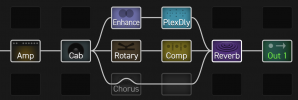Ant Music
Fractal Fanatic
Ok I’ve been toying around a bit more with the Rotary block and tried out a couple of different people patches from axechange to see how I can improve my Rotary tone.
I had a bit of a break through when I noticed that the mix dial is actually where I found what I was looking for. Normally, I automatically turn the mix parameter up full so as to get the most authentic rotary sound (not wanting to dilute it with dry signal) and the most pronounced stereo effect.
I noticed that when I returned the mix dial to 50% the character I’d been missing was there. It seems like the mix parameter behaves similar to that of a phaser or chorus pedal, in that if you max it out you don’t get the full interaction between the wet and dry signals (50/50 gives the most pronounced effect)
So I’m really enjoying the sound and texture of it but now I feel like I’m not getting the full stereo separation I’m after having reintroduced the dry signal into it, even with the stereo image parameter up full. What do you guys make of this? I’m happy with the tone/texture but now I feel like it’s at the sacrifice of the stereo image separation.
Am I right about the behaviour of the mix parameter? How do you guys approach this?
I had a bit of a break through when I noticed that the mix dial is actually where I found what I was looking for. Normally, I automatically turn the mix parameter up full so as to get the most authentic rotary sound (not wanting to dilute it with dry signal) and the most pronounced stereo effect.
I noticed that when I returned the mix dial to 50% the character I’d been missing was there. It seems like the mix parameter behaves similar to that of a phaser or chorus pedal, in that if you max it out you don’t get the full interaction between the wet and dry signals (50/50 gives the most pronounced effect)
So I’m really enjoying the sound and texture of it but now I feel like I’m not getting the full stereo separation I’m after having reintroduced the dry signal into it, even with the stereo image parameter up full. What do you guys make of this? I’m happy with the tone/texture but now I feel like it’s at the sacrifice of the stereo image separation.
Am I right about the behaviour of the mix parameter? How do you guys approach this?



